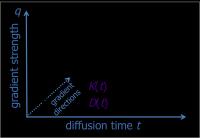|
Weekend Educational Course: Diffusion MRI Light
Skill Level: Basic to Intermediate
Organizers: Daniel C. Alexander, Ph.D., Chunlei Liu, Ph.D. & Stephan E. Maier, M.D., Ph.D.
Saturday 07 May 2016 |
Overview
This course will introduce fundamental principles and methodologies of diffusion MRI. The first three lectures will focus on the basics of generating diffusion contrast in MRI, mathematical models for analyzing diffusion-encoded signals and methods for extracting microstructural information of tissues. The following two lectures will showcase the practical application of diffusion MRI in tractography and population studies. Ample opportunity will be provided for interaction between audience and speakers.
Target Audience
Physicists, technologists and clinicians, who wish to understand the basics and more advanced concepts and applications of diffusion MRI.
Educational Objectives
Upon completion of this course, participants should be able to:
- Understand the concepts of
diffusion weighted imaging (DWI) and diffusion tensor imaging (DTI);
- Comprehend the limitations of
basic DTI and the need for more advanced diffusion models;
- Recognize diffusion MRI
approaches for characterizing tissue microstructure;
- Know different methods for
tractography and be aware of potential applications and limitations;
and
- Select group study approaches
for diffusion data, both for cross-sectional and longitudinal
cohorts.
|
08:30
|
|
Introduction to Diffusion Weighted Imaging 
Ching-Po Lin1
1Institute of Neuroscience, National
Yang-Ming University, Taipei, Taiwan
Diffusion MRI is a technique that can probe
direction-dependent diffusivity of water molecules to
reflect, on a statistical basis, the displacement
distribution of the water molecules present within a MRI
voxel. The observation of this displacement
distribution may thus provide unique clues to the
structure and geometric organization of tissues. Here,
I will review the principle of diffusion MRI and its
applications in neuroscience.
|
09:00
|
 |
Diffusion Tensor Imaging & Higher Order Methods 
Els Fieremans1
1Radiology, New York University School of
Medicine, NY, United States
In this lecture, we will explore the non-Gaussian
diffusion signal as measured in biological tisues by
varying both the gradient wave vector q and the
diffusion time t, the time over which the molecules
diffuse. The concepts of q-space imaging, diffusion
tensor imaging (DTI) and diffusion kurtosis imaging (DKI)
will be covered, as well as other higher order diffusion
methods. In addition, we will illustrate how varying the
diffusion time t provides complimentary information
about microstructural length scales.
|
09:30
|
|
Probing Microstructure with Diffusion MRI 
Markus Nilsson1
1Dept. of Diagnostic Radiology, Lund
University
Diffusion MRI can be used to non-invasively quantify
brain microstructure by using analysis methods and
models more accurate than diffusion tensor imaging.
Biophysical models of diffusion MRI describe the MR
signal as originating from diffusion in distinct tissue
components, such as the intra-axonal or extracellular
space. Comparment sizes, e.g., the average axon
diameter, can be estimated using diffusion MRI, provided
that the size is above the resolution limit of the
acquisition protocol. Orientation dispersion is
essential to include in white matter diffusion models.
|
10:00
|
|
Break & Meet the Teachers |
10:15
|
|
Diffusion Tractography: Principles & Methods 
Maxime Descoteaux1
1Computer Science, Université de Sherbrooke
The audience will learn the basic principles of
diffusion tractography and be cautious of the
limitations of current methods. In particular, the
audience will learn the difference between Diffusion
Tensor Imaging (DTI) and High Angular Resolution
Diffusion Imaging (HARDI) tracotgraphy, from both a
deterministic and probabilistic point of view.
|
10:45
|
|
Applying Diffusion MRI in Population Studies 
Ragini Verma
The talk will cover various aspects of processing and
analysis of diffusion data, from the perspective of
population studies. Specifically it will discuss
connectome creation, connectomic analysis, automated
tract extraction and biomarker creation. In addition to
describing the protocol for cross-sectional studies, we
will also discuss the extension of these methods to
longitudinal studies. In addition to the description of
methods, application to clinical populations will be
presented.
|
11:15
|
|
Panel Discussion |
12:00
|
|
Adjournment & Meet the
Teachers |
|

